| LESSER KNOWN ACTORS - BANDď |
| Band˘ Aiz˘ Band˘ Aiz˘ |
|||||
|
Born in 1747. Disciple of Ichimura Uzaemon VIII, he started his career in the 11th lunar month of 1757, performing at the Ichimuraza under the name of Band˘ Aiz˘ as a koyaku in the kaomise program "Matsuhata Suma no Wakezato". He became wakashugata in the 11th lunar month of 1762, performing at the Ichimuraza in the kaomise drama "Kisoe Uta Sakae Komachi", which celebrated the shűmei of Ichimura Uzaemon IX and ďtani Hiroji III. He became wakaonnagata in 1764. He took the name of Sanogawa Ichimatsu II in the 11th lunar month of 1767 at the Moritaza, becoming wakashugata and playing the role of Kajiwara Genta in the kaomise drama "Sanada no Yoichi Banjaku no Iezuto", which welcomed in Edo the Kamigata actor Yamashita Ky˘nosuke. He became most likely a disciple of Matsumoto K˘shir˘ IV, specializing himself in iroaku roles and taking the name of Matsumoto Sanjűr˘ in the 11th lunar month of 1781, when he performed at the Ichimuraza in the kaomise drama "Mukashi Otoko Yuki no Hinagata", which also celebrated the shűmei of Ichiyama Sukejűr˘. He took back the name of Band˘ Aiz˘ in the 11th lunar month of 1784, playing at the Kiriza the role of Katsura Sakingo in the kaomise drama "Jűni Hitoe Komachi Zakura". This was unfortunately his last stage appearance. His last ranking in an Edo hy˘banki, tachiyaku section, was one white stroke above j˘-j˘ [visual]. He died the 26th of the 8th lunar month of 1785.
|
|||||
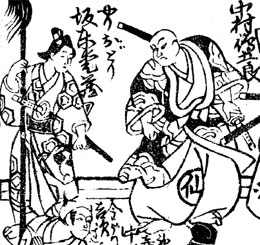 |
|||||
|
Band˘ Aiz˘ (left) and Nakamura Shimagor˘ (right) performing in the kaomise drama "Kachidoki Sakae Genji", which was staged in the 11th lunar month of 1765 at the Moritaza |
|||||
| Band˘ Ch˘emon Band˘ Ch˘emon |
|||||
|
Born in Sendai the 6th of October 1896. He was the son of the show manager Takase Kichibŕ and his real name was Takase Daisuke. He started his career in ji shibai in 1903, performing in Shinpa. He settled in T˘ky˘ in 1917 and became a disciple of Band˘ Shűch˘ III. He received the name of Band˘ Ch˘emon in 1922. He joined the Zenshinza troupe in May 1931. He received the title of Meritorious Member of the Troupe in 1971, after 40 years of supporting roles performances for the Zenshinza troupe. His best role was Tonbŕ in "Yaguchi no Watashi". He died the 19th of February 1982. He was the grandfather of Nakamura Sennoj˘ II. |
|||||
| Band˘ Heiroku Band˘ Heiroku |
|||||
|
Dates of birth and death unknown. He was recorded for the first time in the 11th lunar month of 1718, when he performed as a d˘kegata in ďsaka at the Kita no Shinchi Shibai in the kaomise drama "In'y˘ Inui no Machi-zukuri", which was produced by Kokon Shinzaemon. He settled in Ky˘to in winter 1720 and he played the role of the wakadono Mondo in the ni-no-kawari drama "Keisei Mirume no Seki", which was produced by Ogino Yaegiri I. His rank in the 1721 Ky˘to hy˘banki, d˘kegata section, was j˘-(shiro)j˘ (superior - (white) superior) [visual]. He was recorded for the last time in the 12th lunar month of 1722, when he performed as a d˘kegata for the zamoto Otowa Jirosabur˘ I at Daikokuya Takenoj˘'s theater in a kaomise program (unknown title), which starred Yoshizawa Ayame I, Matsumoto Shigemaki, Nakamura S˘jűr˘, Miyazaki Giheita, Kanazawa Hikogor˘ II, Yamatogawa Gorojir˘, Iwai Izaemon, Fujioka Daikichi, Kirinami Senju II, Ichikawa Toyama III, Ichikawa Takegor˘, Mizuki Masano and Band˘ Matasabur˘ I. No record afterwards. |
|||||
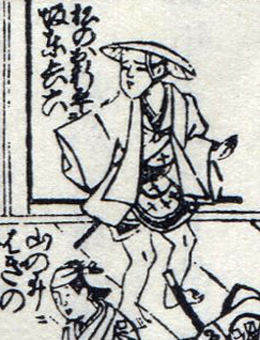 |
|||||
|
Band˘ Heiroku playing the role of the yakko Shinpei in the kaomise drama "Banshiki Kogane no Miyako", which was staged in the 11th lunar month of 1721 in Ky˘to at Hoteiya Umenoj˘'s theater |
|||||
| Band˘ Kichiroku Band˘ Kichiroku |
|||||
|
Date of birth unknown. He started his career in Kamigata as a disciple of Arashi Kichisabur˘ III, who gave him the name of Arashi Kichiroku. After the death of his first master, he joined the Otowaya branch of the Band˘ clan in Edo. He took the name of Band˘ Kichiroku [8] in the 8th lunar month of 1866 at the Moritaza, performing in the drama "K˘tei Kidan Rokujű Yoshű". This supporting hand˘gataki actor was said to be outstanding in the role of the passer-by in "Sukeroku". He died the 13th of October 1901. He was the father of Band˘ Minosuke V.
|
|||||
 |
|||||
|
Nakamura Kantar˘ I (left) and Band˘ Kichiroku (right) playing the roles of Fujiya Izaemon and ďgiya Yűgiri in the drama "Kuruwa Bunsh˘", which was staged in November 1897 at the Shintomiza (print made by Utagawa Yoshiiku) |
|||||
| Band˘ Mitsusabur˘ Band˘ Mitsusabur˘ |
|||||
|
Born the 4th of January 1913. He started his career a disciple of Band˘ Mitsugor˘ VII in April 1920 at the Ichimuraza, where he received the name of Band˘ Mitsuya. He became nadai in July 1941, celebrating this event in ďsaka at the Nakaza by performing in "Kumagai Jin'ya" and "Aoyama Harima". He took the name of Band˘ Mitsusabur˘ in January 1947, in ďsaka at the ďsaka Kabukiza, where he performed in "Osaga Kaheiji", "Nageki no Tenshi" and "Kioi Jishi". These dramas were part of a special program, which celebrated the shűmei of Nakamura Ganjir˘ II and Kamimura Kichiya V, and commemorated the 12th anniversary (13th memorial service) of the passing away of Nakamura Ganjir˘ I. He appeared on stage for the last time in June 1986 at the Kabukiza, where he played the role of the farmer Kichisuke in the drama "Kumagai Jin'ya". He left the Kabuki world in 1988. No record afterwards (unknown day of death). He was a supporting tachiyaku actor who served for more than 66 years four generations of masters of the Band˘ clan, from Band˘ Mitsugor˘ VII to Band˘ Yasosuke V.
|
|||||
| Band˘ Sadajűr˘ Band˘ Sadajűr˘ |
|||||
|
Date of birth unknown. He started his career around 1737 as an iroko at the Nakamuraza, performing under the name of Yamatogawa Utagiku. He became a disciple of Sawamura Kodenji II and received the name of Sawamura Utagiku. He became wakaonnagata at the beginning of the 1740s and took the name of Sawamura Kodenji III in the 11th lunar month of 1756, performing at the Moritaza in the kaomise drama "Manazuru Heike Monogatari". He became kashagata and took the name of Band˘ Sadajűr˘ in the 11th lunar month of 1764. He held it up to his death the 10th of the 6th lunar month of 1771. |
|||||
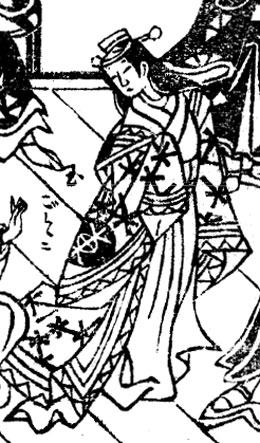 |
|||||
|
Band˘ Sadajűr˘ playing the role of Yuriwaka's elder sister in the new year drama "Mina Mezame Yuriwaka Daijin", which was staged in the 1st lunar month of 1767 at the Moritaza |
|||||
| Band˘ Shinzaemon Band˘ Shinzaemon |
|||||
|
Year of birth unknown. He was most likely a disciple of Band˘ Hikosabur˘ IV. His first stage name was Band˘ Sasahei. He took the name of Band˘ Shinzaemon in 1858 and held it up to his death in 1875. He played the roles of Kamaya Buhŕ in the drama "Kichisama Mairu Yukari no Otozure", which was premiered in the 7th lunar month of 1869 at the Nakamuraza [casting]. |
|||||
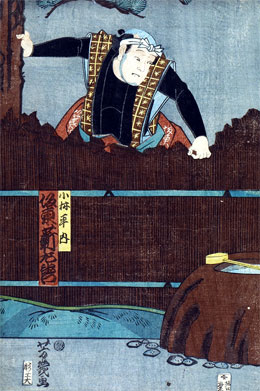 |
|||||
|
Band˘ Shinzaemon portraying Kobayashi Heinai in a print made by Utagawa Yoshiiku in 1863 |
|||||
| Band˘ Tachibana Band˘ Tachibana |
|||||
|
Born the 28th of January 1926 in T˘ky˘. He started his career as a disciple of Ichikawa Ebiz˘ IX in June 1947 at the Mitsukoshi Gekij˘, where he played the role of a shinz˘ in "Gosho no Goroz˘". His first stage name was Ichikawa Masuya. He became nadai and celebrated it in October 1954 at the Kabukiza, where he received the name of Ichikawa Ebiji and played the roles of a jijo, the jochű Omasu, a bonze and the old woman Yoshikawa in "Nippon Kenj˘ki", "Ninj˘ Banashi Koban Ichiry˘", "Musume D˘j˘ji" and "Ejima Ikushima". He became a disciple of Ichimura Uzaemon XVII and received the name of Band˘ Tachibana in January 1966 at the Kabukiza, where he played the roles of the nakai Omino and the koshimoto Kiky˘ in "Yoshidaya" and "Shigenoi Kowakare". He appeared on stage for the last time in July 2001, in T˘ky˘ at the National Theatre, where he performed in "Bunshichi Mottoi". He retired after 54 years spent on stage or backstage. He died the 19th of December 2007.
|
|||||
| Band˘ Tar˘ | |||||
|
==> Dedicated page: Band˘ Tar˘ |
|||||
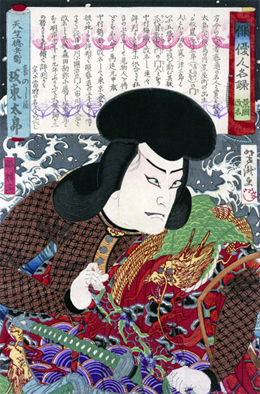 |
|||||
|
Band˘ Tar˘ portraying the role of Tenjiku Tokubŕ in a print made by Ichiy˘tei Yoshitaki |
|||||
| Band˘ Tasabur˘ Band˘ Tasabur˘ |
|||||
|
Born in January 1916 in T˘ky˘ in Asakusa. His familly was in charge of a footwear wholesale business. As a child, he fell in love with the art of Kabuki. In July 1923, he became a disciple of Ichimura Kamez˘ III, who gave him the name of Band˘ Kikk˘. He made his debut on stage in August 1923, in Asakusa at the Sh˘chiku Mikuniza, where he played the role of the Hamamatsuya decchi in the drama "Benten Koz˘". He joined the Zenshinza in 1923 and performed under the name of Suzuki Ichir˘ from June 1923. He took the name of Band˘ Tasabur˘ in January 1953, most likely at a Zenshinza venue, where he performed in the drama "Toribeyama Shinjű". He was an important supporting actor and became in his latter years a fukeyaku actor. He was also a movie/TV drama actor. He died the 23rd of August 1991.
|
|||||
 |
|||||
|
Band˘ Tasabur˘ |
|||||
| Band˘ Toyokichi Band˘ Toyokichi |
|||||
|
Dates of birth and death unknown. Son [1] of Band˘ Toyosabur˘ I and younger brother of Band˘ Kikumatsu, he made his debut on stage in Ky˘to in the 11th lunar month of 1760, performing as an iroko in the kaomise drama "ďshimadai Kitsune no Mukoiri", which was produced by Sawamura Kunitar˘ I. He became wakaonnagata and played in the 11th lunar month of 1765, performing with his father in the kaomise drama "ďzatsuki Shuen no Kachidoki" [2], which was produced by Nakamura Utaemon I. He went to Edo in Winter 1768. He performed in the new year sogamono drama "Shuen Soga ďmu Gaeshi", which was staged in the 2nd lunar month of 1768 at the Ichimuraza. He went back to ďsaka at the beginning of the 1770s. He was active in ďsaka up to the end of the 1770s. No record afterwards [3]. |
|||||
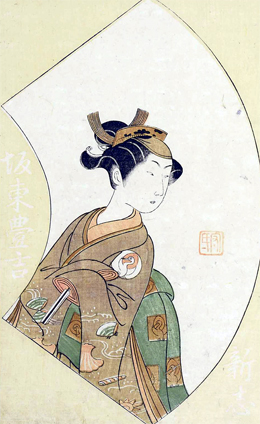 |
|||||
|
The actor Band˘ Toyokichi in a print made in 1770 by Ippitsusai Bunch˘ for the Ehon Butai ďgi series of prints |
|||||
| Band˘ Tsuruemon Band˘ Tsuruemon |
|||||
|
Born the 15th of February 1886 in Iwate Prefecture. He started his career as a disciple of the travelling actor Nakamura Kimisabur˘, who gave him the name of Nakamura Kimitar˘. He made his debut on stage in March 1896 in Nemuro at the Nemuroza. In January 1898, the troupe led by his master Nakamura Kimisabur˘ performed with the troupe led by the T˘ky˘ actor Iwai Matsunosuke IV. He left Nakamura Kimisabur˘ to join Iwai Matsunosuke IV as a disciple. He received the name of Iwai Tokumatsu. He took back the name of Nakamura Kimitar˘ in January 1901 and performed in tabi shibai all over Japan for many years. He became the leader of his own travelling troupe, the Nakamura Kimitar˘ Ichiza in May 1910 in Hamamatsu. He met Band˘ Hikosabur˘ VI and became his disciple in 1923. He took the name of Band˘ Tsuruemon in January 1924 at the Ichimuraza. He became nadai and celebrated it in June 1935 at the Kabukiza. He appeared on stage for the last time in December 1960, at the Kabukiza, where he played the role of a farmer in the drama "Terakoya". He retired after 65 years spent on stage and died the 30th of May 1972.
|
|||||
| Band˘ Usabur˘ Band˘ Usabur˘ |
|||||
|
Born the 2nd of March 1896 in T˘ky˘ in the district of Kanda. Disciple of Ichimura Uzaemon XV, he received the name of Band˘ Usabur˘ and started his career in November 1908 at the Kabukiza, where he played the role of a kosh˘ in the drama "Sangoku Bus˘ Hisago no Gunbai". He most likely became nadai in October 1918 [4]. He joined the Onoe Kikugor˘ Gekidan in May 1955 at the Kabukiza, where he played the role of the goze Osuzu [5] in the drama "Kagatobi" which was staged within a program commemorating the 6th anniversary (7th memorial service) and the 12th anniversary (13th memorial service) of the passing away of Onoe Kikugor˘ VI and Band˘ Hikosabur˘ VI and the hatsubutai of Onoe Einosuke II. He appeared on stage for the last time in May 1978, in T˘ky˘ at the Kabukiza, where he played the role of the nakai Akino in the drama "Ise Ondo Koi no Netaba". He officially retired the 30th of April 1979. Date of death unknown. This supporting onnagata actor was well appreciated in the Kabuki world, where he was affectionaly nicknamed Usa-chan.
|
|||||
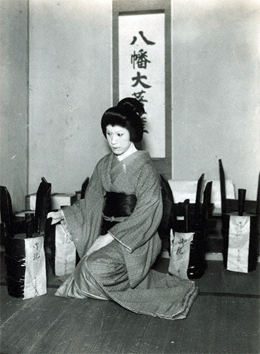 |
|||||
|
Band˘ Usabur˘ playing the role of Ikkaku's elder sister Orie in the drama "Shimizu Ikkaku", which was staged in November 1927 at the Sh˘chikuza in Asakusa |
|||||
| Band˘ Yaenosuke Band˘ Yaenosuke |
|||||
|
Born the 25th of March 1909. He started his career as a disciple of Nakamura Fukusuke IV in 1920 in ďsaka. He became a disciple of Band˘ Hikosabur˘ VI in December 1924 and received the name of Band˘ Yaenosuke. He became during the Sh˘wa era the most important tateshi in Kabuki. He was in charge of crafting spectacular tachimawari, especially for the Onoe Kikugor˘ Gekidan troupe. The best examples were the tachimawari in "Ranpei Monogurui", "Kokingo Uchijini", "Suzu-ga-Mori" (the fight in the dark between Shirai Gonpachi and the group of kumosuke) and "Shiranami Gonin Otoko" (the fight on the roof of the Gokurakuji Temple). His art of tateshi was designated as an Important Intangible National Treasure in 1964. He trained Kabuki students at the National Theatre training center and trained several tateshi. He died the 7th of January 1987.
|
|||||
|
|
|||||
|
[2] There were two zamoto at the Naka no Shibai, Mimasu Daigor˘ I and Nakamura Utaemon I, and there were two kaomise dramas produced in this theater. Nakamura Utaemon I produced the two dramas and Mimasu Daigor˘ I produced only the second drama. The two dramas had a different casting but used the same title "ďzatsuki Shuen no Kachidoki". Band˘ Toyokichi performed in the second drama. [3] A wakaonnagata actor named Band˘ Toyokichi was recorded as performing in hama shibai between 1795 and 1798. It was most likely a different actor. [4] An actor named Ichimura Usabur˘ was recorded as a new nadai in October 1918. Most likely this Ichimura Usabur˘ could have been Band˘ Usabur˘. [5] Osuzu or Orei. Two possible readings. [6] His yag˘ when he was Arashi Kichiroku. [7] His yag˘ when he was Band˘ Kichiroku. [8] It was also the shűmei of Onoe Taganoj˘ II, Band˘ Tar˘ and Band˘ Rinez˘. |
|||||
|
|
| Contact | Main | Top | Updates | Actors | Plays | Playwrights | Programs | Links | FAQ | Glossary | Chronology | Illustrations | Prints | Characters | Derivatives | Theaters | Coming soon | News |